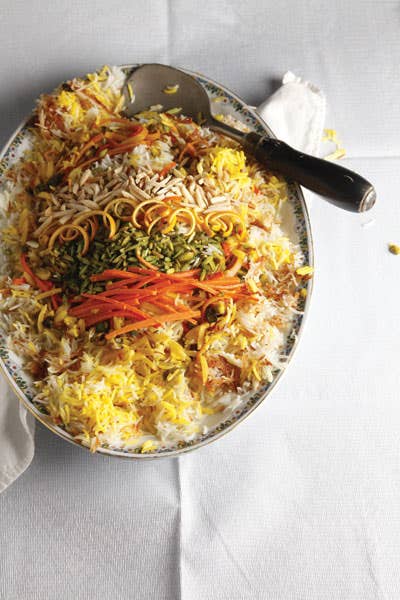
Iran: The Land of Bread and Spice
Iran’s ancient cuisine is as complex and captivating as ever.
In 1982, I had an unforgettable meal at Ava Gardner's house in London. The actress, whom I had met through mutual friends, was charming in every way, but truth be told, it was the food that really wowed me. It had been prepared by a glamorous Iranian woman who had befriended Ava when she was filming Bhowani Junction in Pakistan in the mid 1950s, and I had never tasted anything like it. There was a platter of fluffy white rice speckled with saffron-colored grains and topped with golden pieces of a crisp, wafer-like rice crust, called tah dig. There were bowls of torshi, Iranian pickles made with everything from cabbage to cucumbers, designed to cut through the incredible richness of the meaty stews on the table, and rice- and lamb-stuffed grapevine leaves that were served with a sweet-sour tomato sauce, so unlike the plain ones I knew as a child growing up in Lebanon.
Years later, when I began researching culinary history and writing about food, I often thought back to that meal. Iranian cooking is legendary in the realm of Middle Eastern food, and many dishes across that part of the world can trace their roots to Persian precedents: For example, take Morocco's fragrant tagines, relatives of Iran's khoresht stews, or the sweet-tart savory dishes whose distinctive flavor is achieved by cooking meat with fresh or dried fruit, which originated in Persia during ancient times. Persians brought their cuisine to the Indian subcontinent in the Middle Ages, and to this day the Persian and Hindi names for many dishes are nearly identical. (Persia is what the country was long known as in the west; in 1935, the Shah asked the international community to use the country's native name, Iran.)
The Persian Empire, which spanned with some interruptions from 550 BC to AD 651, was the greatest of the early civilizations; there were well-built roads from one end of the empire to the other, and caravansaries, or roadside inns, at regular intervals to provide shelter and food to travelers. Herodotus, the Greek historian, wrote that he was seduced by Persian food, and King Croesus of Lydia, an ancient land that is now part of Turkey, advised Cyrus the Great to lure troublesome tribes with "the good things on which the Persians live." Between the middle of the eighth century to the mid 13th century, the Abbasid Caliphate, an Arab-Muslim dynasty that encompassed swaths of the Middle East, North Africa, and parts of Spain and Portugal, hired Persian chefs to cook for the heads of state. As Islam tightened its hold on the region, Arabs adopted and adapted Persian cuisine.
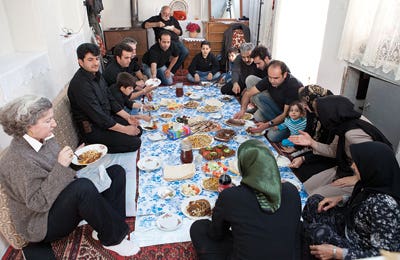
I've enjoyed cooking with Iranian friends in London and Los Angeles, two cities with large expat communities, but I desperately wanted to know the cuisine, its ingredients and techniques, more intimately. So when a friend of mine, an architect named Nasrine Faghih, moved back to her native Tehran a few years ago, I hatched a plan. I have a Lebanese passport, which makes it easy for me to get a visa; relations between the two countries are friendly. Through Nasrine and other Iranian friends' networks, I set up a series of cooking dates for a visit this past December, both to the city and to areas nearby that are known for their regional specialties.
Tehran is a sprawling modern city of about eight million people that has been developed rather haphazardly over time. It's the country's cultural capital, laying claim to a thriving intellectual and artistic scene and a vibrant social life, much of which takes place behind closed doors in people's homes. I had actually been there once before in the mid 1970s, when the Shah was still in power; it was a quick work trip and I didn't get a sense of the local cuisine. Shortly after that visit, the people revolted against his corrupt rule and everything changed.
For a brief period after he was exiled in 1979, there was eurphoria among Iranians at the prospect of national unity and a more promising future. Little did they know that their revolution had paved the way for a repressive Islamic state where women had to hide their hair and hips and where alcohol and many other pleasures were outlawed. When I returned last year, I was struck by how life in Tehran is one of paradoxes: gray and drab on the outside and fun and even glamorous away from the authorities' watchful eyes. The lunches and dinners I went to were joyful and generous, despite the general sense of dejection at how the 2009 protests against the contested election results had led nowhere. It moved me that, even in the face of such hardships, the food culture of Iran had not only survived, but thrived.
On my first day back in Tehran, I visited the markets, which were in full bloom with produce from the country's rich agricultural west. In Tajrish, one of the city's nicest outdoor bazaars, women—some clad in chadors, a full-body cloak, others elegantly dressed under long coats, with loose scarves draped over their hair—were buying what I recognized to be the cuisine's elemental ingredients: fresh pomegranates and limes, both fresh and dried; pickled vegetables and dried fruit; and delicate threads of saffron, the dried stigmas of the native crocus flower that tint food yellow and give it a subtle, earthy spice. There were bins full of cardamom pods and cinnamon sticks, bottles of rose and other waters distilled from herbs and flowers, and the spice mix called advieh, comprising turmeric, cumin, ground coriander, and other spices, which I had read about in a book I'd owned for years, The Legendary Cuisine of Persia (Grub Street, 2002), by the late cookbook author Margaret Shaida. As we wandered through the stalls, Nasrine explained the use of foods that were unfamiliar to me: sour fruit jellies that looked like tiny jewels, used as a relish to flavor fish dishes, and dried orange-blossom petals for tisanes.
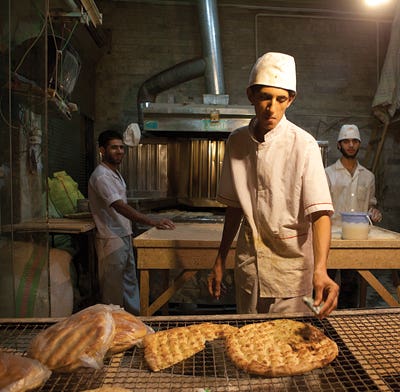
Nasrine was excited for me to cook with her friend Minou Saberi, whom she said made the most delicious khoresht, the Iranian-style stew where meat, herbs, and vegetables or fruit slowly simmer until the whole is thick and rich. After my market tour, Saberi, a kind woman in her 70s who passed away shortly after my visit, joined me in Nasrine's kitchen and made an elegant khoresht with chicken, walnuts, and pomegranate molasess—another staple Iranian ingredient. As we ate the sweet, tart stew with white rice, Saberi explained that khoresht was different from abgusht, another style of stew where meat and vegetables are cooked in broth, removed and pounded to a paste, and then returned to thicken the soup with torn pieces of bread. In almost all of these stews, the predominant flavorings of Iranian cooking are front and center: saffron, which is ground and mixed with water before it's added to everything from rice to vegetable oil that is drizzled over finished dishes; Omani limes, an intensely flavorful variety, which are dried and used whole or ground for a dash of sour flavor; and sumac, the lemony tasting, crimson-colored berries that are ground into tart powder.
Saberi also prepared baghali ghatoqh, a specialty from the north made with beans and sabzi—a mix of wild herbs, spinach, and scallions that Iranian cooks use in massive quantities, both cooked, as in this case, and raw, to add a refreshing counterpoint to rich dishes. Saberi had bought hers at the market earlier that day; there are stalls that sell only sabzi, with each of the greens in separate crates so that the blend can be tailored to each customer's tastes. The vendor chopped the ingredients together in a machine that resembled a meat grinder, and packed the sabzi in a big plastic bag. I asked Saberi if some cooks thought chopping by hand was preferable. "You may want to spend hours chopping a mountain of herbs," she said, "but I have better things to do with my time."
It didn't take long after my arrival in Iran to realize that bread is another huge staple of the cuisine: While rice is often thought of as Iran's iconic food, I found that cooks usually reserve rice dishes, particularly elegantly spiced ones laden with dried fruit and nuts, for guests and special occasions. Bread, on the other hand, is everywhere, though it's never taken for granted: It's considered sinful to let bread fall to the ground or be discarded. If it becomes too dry, it is broken and added to soups or ground to make bread crumbs.
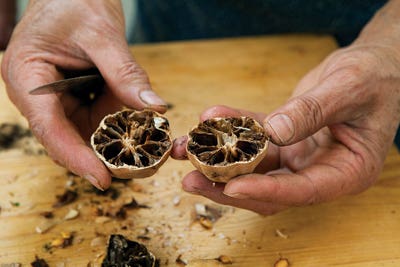
It was in Tehran's bakeries that I first experienced the legendary hospitality of Iranian cooks. Every time I stopped to watch the baking, I would be offered warm bread to take home. One morning, about a week after I arrived, I became mesmerized watching the bakers at a place near Nasrine's house. They were making nan-e sangak, a bread that's baked over hot pebbles lining the bottom of a wood-fired oven, leaving charred indentations on the loaf. One baker shaped some incredibly wet dough into a long oval, which he flopped onto a peel that another baker then slipped into the oven, depositing the unbaked loaf and then swiftly removing a baked one. The cooling oblong breads hung against a wall on something like a coat rack to keep them from getting soggy with steam. While sangak is eaten with everything from stews to kebabs, lavash is even more common: The very thin rectangular or oval flatbread can be stored for days and made soft again by sprinkling with a little water and reheating. It is often used as a utensil, to scoop up food, or as a wrap for ingredients.
Later that morning, I had a particularly wonderful breakfast at a modest cafe where the owner, who was very old but still swiftly shuttling between his stove and tables, brought me a warm loaf of nan-e barbari, a seeded loaf similar to Turkish pide, from a neighboring bakery, along with a plate of fresh feta-like cheese and tea. I was the only woman there that morning; the rest of the clients were as old as the cafe owner, and they were all sipping their tea through sugar cubes, as is done throughout Iran, and wrapping their cheese with folds of that delicious bread.
As much as Iranians respect bread, they revere rice (berenj in Persian), and they have turned the cooking of it into an absolute art form. Many Iranians buy rice and rock salt—the only salt traditionalists will use with rice—at stores that sell nothing but these ingredients. I encountered such a shop, in Bandar-e Anzali, the caviar capital on the Caspian Sea, when I left Tehran for a few days to explore Gilan province in the northwestern part of the country. It had half a dozen sacks of rice, each with a sign indicating the variety and price. It was here that I heard a woman ask the age of the rice she was buying, and discovered that discerning Iranian cooks prefer their rice to be at least a year old. "You shouldn't eat freshly harvested rice," she said in broken English as she gestured for me to smell the grains. "It needs to be fragrant."
I've never seen so many different ways of cooking rice as I did in Iran. The following day, I visited Tahereh Akbar and her daughter Laleh Akbar at their home in Rasht, the capital of Gilan province. In their small, modern kitchen, the women showed me how to make rice the way cooks do in northern Iran: a style called kateh that calls for cooking the rice until the water is absorbed and a crisp layer forms on the bottom and sides of the pan. Tey also made tah chin, a baked rice dish that's inverted, cut into squares, and sprinkled with dried barberries, a local fruit with a tart flavor, and currants, which gave the dish an even more appealing aroma and texture.
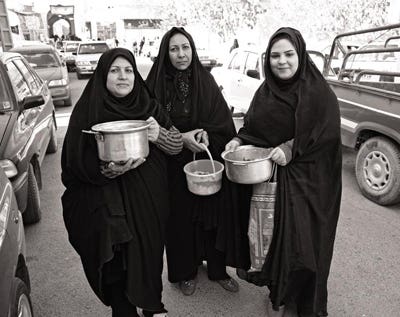
Kateh's rice crust is less pronounced in flavor and texture than the coveted tah dig, a crust that is the distinguishing feature of many of Iran's most elaborate rice dishes, or polows. I tasted one such dish the very next day at the home of Fereydoon AbbasNejad, a burly man with the most extraordinary handlebar moustache, on a farm outside the city of Qazvin, south of Gilan province. He and his family prepared a "jeweled" shirin polow, a festive dish studded with chicken, orange rind, and pistachios, with shami kebab, succulent ground beef kebabs seasoned with turmeric, cinnamon, and saffron. AbbasNejad parboils his rice before steaming it, and tastes it at regular intervals as it cooks, the way Italians taste pasta to ensure the right degree of al dente texture. He explained that the grains needed to retain a hint of bite on the inside, but not feel brittle.
AbbasNejad drained the cooked rice, then to make tah dig, he placed lavash over the bottom of a pot before spooning the drained rice over top, and putting it back on the stove to crisp up. Purists make tah dig just with rice—which is how I like it—or by covering the bottom of a pot with thinly sliced potatoes. But AbbasNejad's way with bread, which created a golden crust that he mixed in with the rice so you got some tender and some crisp bits with each bite, was delicious, and made the polow feel even more substantial and special.
While we cooked together, I was amused to see this big man carefully wrap each of the lids for his rice pots with a fitted cloth. As I travelled around Iran, I noticed that every household has a selection of different-size fitted cloths designed to prevent condensation on the lid from dripping back into the rice and ruining its perfect texture.
Perhaps the best time of the year to experience Iranians' legendary hospitality is Ashura, a solemn day in December for Shia Muslims that commemorates the martyrdom of the prophet's grandson at the battle of Karbala. I happened to be in Isfahan, Iran's third-largest city, for the holiday, when people prepare food to distribute not only to the poor but also to neighbors and friends. The cooks at the hotel where I was staying prepared a cauldron of khoresht-e gheimeh (a stew made with lamb and split peas) that they placed in the hotel's entrance next to a gigantic pot of rice. As neighbors filed in, servers filled Styrofoam containers for them to take home. But even more impressive was the kitchen of the nearby mosque where cooks were preparing enough chicken and lamb khoresht to feed a few thousand people. In the back room, lambs were awaiting slaughter while men butchered more than a thousand chickens for the stew.
When I returned to Tehran later that evening, I found that Nasrine's neighbor had brought us a plate of cakelike halvah, a dessert that she had made with toasted flour, sugar, and saffron and molded into an elaborate star pattern. As Nasrine and I sat at the table, enjoying the sweet and beautiful confection, it occurred to me that while none of my meals on these two trips to Iran had been as formal or fancy as my first taste of the cuisine at Ava Gardner's house all those years ago, they had been just as delicious and gracious.
Keep Reading
Continue to Next Story










